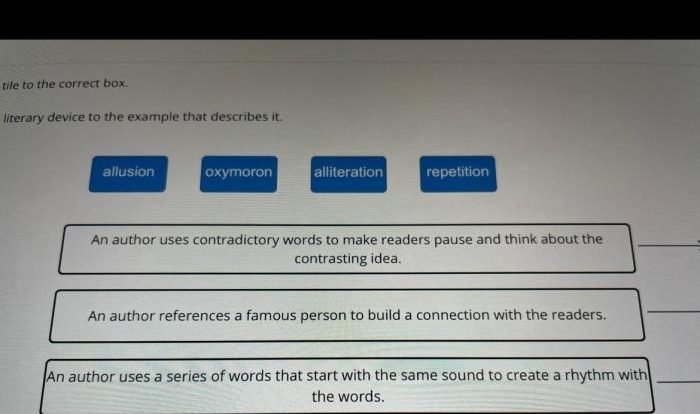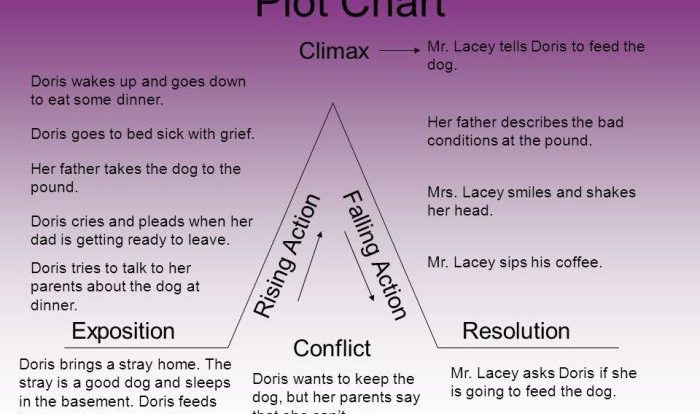Literary devices in raisin in the sun – In Lorraine Hansberry’s acclaimed play “A Raisin in the Sun,” literary devices play a pivotal role in shaping the narrative, conveying deeper meanings, and enhancing the audience’s emotional experience.
This exploration delves into the intricate tapestry of symbolism, metaphor, imagery, foreshadowing, and irony employed by Hansberry, shedding light on their significance and impact on the play’s themes, character development, and overall message.
Symbolism
Symbolism plays a crucial role in “A Raisin in the Sun,” enhancing the play’s themes and character development. The sun, the raisin, and the Younger family home are imbued with profound metaphorical meanings.
The Sun
The sun is a potent symbol of hope and dreams. It represents the Younger family’s aspirations for a better life and their determination to overcome adversity. However, the sun can also be seen as a symbol of unattainability, as the family’s dreams often seem out of reach.
The Raisin
The raisin is a symbol of both the family’s struggles and their resilience. Like a raisin, the family has been dried and hardened by life’s challenges, but they retain their sweetness and hope.
The Younger Family Home
The Younger family home is a symbol of both their aspirations and their limitations. The family dreams of owning a spacious, comfortable home, but their current apartment is cramped and overcrowded. The home represents the family’s desire for a better life, but it also serves as a reminder of their current circumstances.
Metaphor
Metaphors play a significant role in Raisin in the Sun, enhancing the play’s emotional impact and conveying deeper meanings. They allow characters to express complex emotions and abstract ideas in vivid and imaginative ways.
Examples and Significance, Literary devices in raisin in the sun
- “Life is a check drawn on a bank that has failed”: This metaphor expresses the characters’ sense of hopelessness and disillusionment with the American Dream.
- “We’ve been living on the edge of a cliff and now we’re about to fall off”: This metaphor conveys the family’s precarious financial situation and their fear of losing everything.
- “Mama is the rock of this family”: This metaphor highlights Mama’s strength and resilience, and her role as the foundation of the family.
Imagery: Literary Devices In Raisin In The Sun
Lorraine Hansberry’s A Raisin in the Sunis a play that is rich in imagery. Hansberry uses vivid sensory details and evocative language to create a vivid and immersive experience for the reader/audience. The play’s setting is a cramped and rundown apartment in Chicago’s South Side, and Hansberry’s use of imagery helps to convey the poverty and despair that the characters face.
Visual Imagery
Hansberry uses visual imagery to create a vivid picture of the Younger family’s apartment. She describes the apartment as “a small, dark frame house,” with “windows so small that they might as well have been peepholes.” The apartment is also “crowded” and “airless,” and the walls are “dirty” and “stained.”
This visual imagery helps to convey the cramped and oppressive conditions in which the Younger family lives.
Auditory Imagery
Hansberry also uses auditory imagery to create a vivid soundscape of the Younger family’s apartment. She describes the sounds of “children crying,” “dishes clattering,” and “radios blaring.” These sounds help to convey the chaos and disarray of the Younger family’s life.
Olfactory Imagery
Hansberry also uses olfactory imagery to create a vivid sense of the smells of the Younger family’s apartment. She describes the smells of “cooking food,” “stale tobacco,” and “musty furniture.” These smells help to convey the poverty and squalor of the Younger family’s life.
Tactile Imagery
Hansberry also uses tactile imagery to create a vivid sense of the physical sensations of the Younger family’s apartment. She describes the feeling of “the cold, hard floor” on their feet, the “rough” texture of the walls, and the “sticky” feeling of the furniture.
These sensations help to convey the discomfort and hardship that the Younger family faces.
The use of imagery in A Raisin in the Sunhelps to create a vivid and immersive experience for the reader/audience. Hansberry’s use of sensory details and evocative language helps to convey the poverty and despair that the Younger family faces, as well as the hope and determination that they have for a better future.
Foreshadowing
Foreshadowing is a literary device used to hint at or suggest events that will occur later in a narrative. It creates suspense and builds anticipation, allowing readers to speculate and engage with the text more deeply.
In A Raisin in the Sun, Hansberry employs several instances of foreshadowing to shape the play’s plot and character development.
Beneatha’s Dream
Beneatha’s desire to become a doctor foreshadows the challenges she will face as an African American woman pursuing a career in medicine. Her dream is met with skepticism and resistance from her family, hinting at the systemic barriers she will encounter.
The Moving Van
The moving van that arrives at the beginning of the play symbolizes the impending move to Clybourne Park. It serves as a constant reminder of the family’s hopes and fears, foreshadowing the challenges and conflicts that await them in their new neighborhood.
The Insurance Check
Walter’s receipt of the insurance check from his father’s death foreshadows both the potential for financial stability and the conflicts that will arise within the family over how to use the money. It becomes a catalyst for Walter’s dreams and disappointments.
Ruth’s Pregnancy
Ruth’s pregnancy foreshadows the birth of a new generation and the continuation of the family’s legacy. It also hints at the sacrifices and responsibilities that come with raising a child, particularly in the context of the family’s financial struggles.
Irony

Irony is a literary device that involves the use of words or situations to convey a meaning that is different from or opposite to the literal meaning. In “A Raisin in the Sun,” Lorraine Hansberry employs irony in various forms to create humor, emphasize themes, and reveal character flaws.
Situational Irony
Situational irony occurs when the outcome of a situation is unexpected or contradictory to what is expected. In the play, one instance of situational irony is when the Younger family finally moves into their new home only to discover that the neighborhood is hostile and unwelcoming.
This outcome is ironic because the family had eagerly anticipated moving into the new home as a symbol of their progress and success.
Dramatic Irony
Dramatic irony occurs when the audience or reader knows something that the characters in the story do not. In “A Raisin in the Sun,” there are several instances of dramatic irony. For example, the audience knows that Walter Younger’s investment in the liquor store is a risky venture, but Walter himself is unaware of the risks involved.
Verbal Irony
Verbal irony occurs when a character says something that means the opposite of what they intend to say. In the play, Walter Younger often uses verbal irony to express his frustration and anger. For example, when his wife Ruth tells him that she is pregnant, he sarcastically remarks, “That’s great news.
I can’t wait to tell Mama.”
The use of irony in “A Raisin in the Sun” helps to create a complex and nuanced play that explores the themes of race, class, and family. The play’s ironic moments add depth to the characters and make the play more memorable and impactful.
User Queries
What is the significance of the raisin in the play?
The raisin symbolizes the deferred dreams and aspirations of the Younger family, representing the small but precious hope that sustains them amidst adversity.
How does foreshadowing contribute to the play’s plot?
Foreshadowing creates suspense and anticipation, hinting at future events and shaping the audience’s expectations. It enhances the play’s dramatic impact and deepens the audience’s engagement with the narrative.
What is the role of irony in revealing character flaws?
Irony exposes the inconsistencies between characters’ words and actions, highlighting their shortcomings and flaws. It adds depth to characterization and allows the audience to critically evaluate the motivations and behaviors of the individuals in the play.

